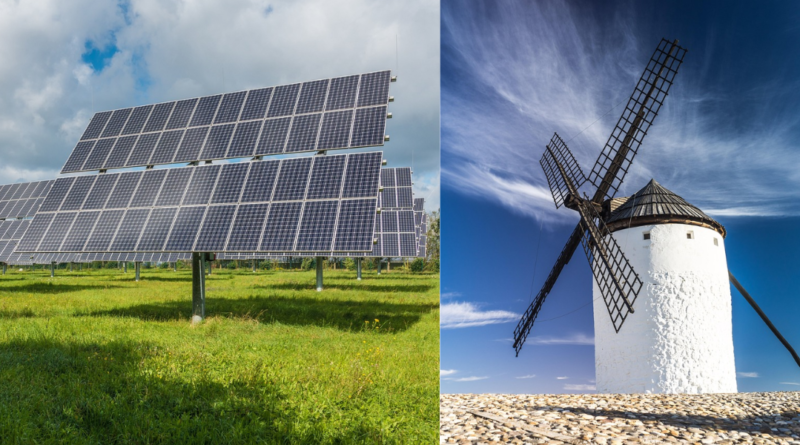Renewable Energy Solutions: Empowering Tomorrow

Introduction:
Renewable energy has become a source of creativity and optimism in a world where sustainable solutions are desperately needed. With the potential of changing our energy landscape and providing the key to a more resilient and environmentally friendly future, “Renewable Energy Solutions: Empowering Tomorrow” takes you on an adventure into the world of clean, endless power sources. This extensive tradition aims to show the way toward a future in which our energy needs are satisfied in harmony with the natural world as we delve into the nuances of solar radiation, harness the kinetic force of the wind, access the heat that exists inside the Earth, and investigate the transformative potential of biomass.
As the global community faces the escalating challenges of climate change and the depletion of finite fossil fuel resources, the imperative to transition to sustainable and renewable energy sources becomes increasingly evident. In this comprehensive exploration, we will delve into the world of renewable energy, examining its various forms, benefits, and transformative impact on our planet.
Understanding Renewable Energy:
Renewable energy stands at the forefront of our collective efforts to address environmental concerns and pave the way for a sustainable future. In essence, renewable energy sources are derived from naturally occurring processes that are continuously replenished. Sunlight, wind, rain, tides, waves, and geothermal heat are some of these sources. Renewable energy, as opposed to limited fossil fuels, provides a sustainable substitute that not only lessens the effects of climate change but also guarantees a steady, long-term supply of clean energy.(renewable energy)
Solar Power:
Solar power, which absorbs the almost limitless power that the sun emits, becomes a powerful force in the search for environmentally benign and renewable energy solutions. This ground-breaking technology provides a clean, renewable substitute for conventional power sources by using photovoltaic cellhttps://en.wikipedia.org/wiki/Photovoltaicss to turn sunlight into electricity. Let’s explore the nuances and benefits that make solar energy a standout option for sustainable energy.
The Photovoltaic Phenomenon:
The photovoltaic (PV) effect, which happens when specific materials are exposed to sunlight and produce an electric current, is the core element of solar power. Direct current (DC) power is produced by solar panels, which are made up of many photovoltaic (PV) cells that collect sunlight and start an electron flow.
Advancements in Solar Technology:
The efficiency and cost of solar panels have been markedly improved by innovations in the solar sector. Researchers are always working to maximize the conversion of sunshine into energy, from conventional silicon-based cells to cutting-edge thin-film technologies, which makes solar power a more practical and affordable choice.
Residential Solar Solutions:
The increasing use of solar panels in residential settings has given homeowners more independence from the traditional grid and allowed them to produce their own electricity. Net-metering systems enable surplus energy to be returned to the grid, benefiting solar-powered homes financially and environmentally.
Large-Scale Solar Farms:
Larger-scale solar power plants use huge areas of land to set up vast solar panel arrays. These utility-scale installations lessen dependency on non-renewable energy sources while producing electricity for businesses and communities. They also make a substantial contribution to the development of renewable energy.
Off-Grid Applications:
Solar energy is used for more than just producing electricity; it may power off-grid projects and distant places. In areas where access to traditional power sources is restricted, solar-powered lights, chargers, and pumps offer essential functions that promote resilience and sustainability.
Environmental Benefits:
Solar power’s low environmental impact is one of its most alluring features. The generation of solar energy contributes to the worldwide effort to battle climate change and lessen our carbon footprint since it emits no greenhouse gases, in contrast to the use of fossil fuels.
Challenges and Solutions:
Although solar energy is a potential alternative, issues like energy storage and intermittency still need to be resolved. The goal of developments in energy storage technology, such as batteries, is to lessen the variability of solar energy and provide a continuous and dependable source of energy.
As the need for renewable energy grows, solar power offers an efficient solution in addition to serving as a symbol of scientific advancement. By utilizing solar energy, we are paving the path for a cleaner, brighter future in which solar energy is a major source of energy for our communities, companies, and homes. We are getting closer to a more robust and renewable energy source in the atmosphere with every sun light that is converted to electricity on the road toward a sun-powered world.
Wind Energy:
Wind energy, a cornerstone of renewable energy, harnesses the kinetic force of the wind to generate clean and sustainable electricity. This eco-friendly solution involves strategically placing wind turbines to capture the wind’s energy, setting the blades into motion, and converting rotational energy into electrical power.
Key Points:
Turbine Technology:
Wind turbines come in a variety of designs and are frequently found in both offshore and onshore wind farms. Landscapes are dominated by classical horizontal-axis turbines, but new vertical-axis designs and advances in blade technology constantly increase efficiency.
Global Presence:
Global wind energy projects use a variety of wind resources. Offshore wind farms, which take advantage of stronger and more reliable winds at sea, are a complement to onshore wind farms, which are typified by rows of turbines.
Environmental Advantages:
Wind energy has a low impact on the environment. Since there are no emissions when producing power, it greatly lowers greenhouse gas emissions. https://en.wikipedia.org/wiki/Greenhouse_gas contributions and helps in the overall effort against air pollution and climate change
Global Commitment:
Globally, countries are investing more in wind power as a means of demonstrating their commitment to environmentally friendly practices. This plentiful and uncontaminated resource is essential for diversifying energy portfolios and lowering reliance on non-renewable energy sources.
Wind energy plays a major role in the shift to a future of renewable energy because of its quick expansion and flexibility. Every time a wind turbine rotates, we produce energy and have a positive environmental impact that will make the future more robust and sustainable.
Hydropower:

Hydropower, a key component in the field of renewable energy, uses the kinetic energy of flowing water to produce electricity. This tried-and-true method entails constructing dams or other water infrastructure in key locations that collect the energy of rivers and seas and convert the force of water into a reliable and renewable energy source.
Key Points:
Diverse Applications:
There are many different types of hydropower, ranging from cutting-edge run-of-river and tidal energy systems to conventional hydroelectric dams. Each technique makes use of the water’s movement to produce power while taking into account various environmental and geographic factors.
Dam Construction:
Large amounts of water are collected by hydroelectric dams, which are ubiquitous around the world. When water is discharged, it passes through turbines, which transform the raised water’s potential energy into kinetic energy and ultimately electric energy.
Tidal and Wave Energy:
Innovative hydropower methods that harness the energy of ocean waves and tides are represented by tidal and wave energy. By using the regular and predictable patterns of tidal motions, these technologies provide a steady and dependable source of electricity.
Stability and reliability:
An energy source that is steady, dependable, and able to continually produce electricity is hydropower. Because of its dependability, it is an important component of the electrical grid and helps to offset the short-term availability of other forms of renewable energy, such as solar and wind.
Global Contribution:
With nations like China, Brazil, and the United States leading the world in hydroelectric capacity, hydropower contributes significantly to the world’s production of energy. It is essential to attaining goals for energy security and environmental responsibility because of its well-established infrastructure and adaptability.
Hydropower is a key component in the quest for renewable energy because of its capacity to provide renewable energy and its flexibility in different geographic conditions. By using the water’s natural flow to generate electricity, we also help create a cleaner, greener future Green Living Hacks: Simple Ways to Reduce Your Carbon Footprint.
Geothermal Energy:
Geothermal energy, a hidden gem in the world of renewables, harnesses the Earth’s internal heat to produce reliable and sustainable electricity. This environmentally friendly technology taps into the Earth’s natural reservoirs of steam or hot water, providing a constant and renewable source of energy.
Key Points:
Earth’s Internal Heat:
Heat emitted from the Earth’s interior is utilized via geothermal energy. For the purpose of extracting steam or hot water that may be utilized for producing power, hotspots often appear close to tectonic plate borders.
Geothermal Power Plants:
Power facilities built to absorb and transform Earth’s heat are the core part of geothermal energyhttps://en.wikipedia.org/wiki/Geothermal_energy systems (https://en.wikipedia.org/wiki/Geothermal_energy). Usually, steam turbines are used in these facilities, either directly from underground pools or by injecting water to produce steam.
Direct Heating Applications:
Geothermal energy is used for direct heating of buildings, houses, and industrial activities in addition to producing power. Both economical heating solutions and renewable energy sources benefit from this excellent utilization of heat.
Low environmental impact:
The environmental effect of geothermal energy is lower than that generated by traditional fossil fuels. Sustainability in the generation of energy is best illustrated by geothermal power areas, which have a tiny physical footprint and produce little greenhouse gases.
Global Accessibility:
Globally, there are geothermal resources; the Philippines, the United States, and Iceland have the most geothermal capacity. By using the region’s geothermal potential, reliance on non-renewable energy sources is decreased, and energy security is increased.
Sustainable Future:
Geothermal energy is emerging as a key component in the shift to a future that uses renewable energy as countries place more emphasis on lowering their carbon footprints. Its reliability, low impact on the environment, and adaptability make it an important component of the renewable energy mix.
Geothermal energy emerges from the Earth’s interior as a dependable, sustainable, and ecologically friendly source of energy for human use. By drawing on this untapped source of heat, we not only produce energy but also open the door to a more robust and renewable energy system.
Biomass Energy:
One dynamic aspect of renewable energy is biomass energy, which produces electricity by using organic materials from garbage and plants. This green technology replaces conventional fossil fuels with a flexible and renewable source of energy by converting biological materials into a variety of energy forms.
Key Points:
Diverse Feedstocks:
A wide variety of feedstocks are used to produce biomass energy, such as wood, crop waste, agricultural leftovers, and organic byproducts. These substances, which are frequently regarded as waste, are useful resources for the generation of renewable energy.
Conversion Processes:
There are several ways to turn biomass into energy, including gasification, fermentation, and burning. By releasing the biomass’s stored energy, these techniques provide biogas, biofuels, heat, and electricity.
Bioenergy Applications:
Applications for biomass energy include the production of biofuels, electricity, and heat. Biofuels provide a greener alternative to traditional fossil fuels for transportation, while biomass power plants use the burning of organic materials to produce energy.
Carbon Neutrality:
The carbon dioxide that is emitted during burning and the quantity that plants absorb during growth are about equal, which is why biomass is regarded as carbon-neutral. By separating biomass from fossil fuels, this closed carbon cycle helps reduce global warming.
Waste-to-Energy:
Biomass energy plays a crucial role in waste-to-energy initiatives by utilizing organic waste materials. This not only reduces the burden on landfills but also transforms waste into valuable resources for power generation.
Community and Agricultural Benefits:
The generation of bioenergy, forestry, and agriculture jobs generated by biomass initiatives enhances local economies. Using agricultural wastes for biomass energy also contributes to the long-term sustainability of agricultural waste.
Biogas from Anaerobic Digestion:
Biogas is a natural gas that is produced by the anaerobic digestion of organic waste. This approach lowers methane emissions from organic decomposition and helps manage trash in addition to producing clean electricity.
Challenges and Sustainability:
Biomass has long-term advantages, but there are drawbacks as well, including emissions from specific feedstocks, competition for resources, and land usage. For renewable energy from biomass to be viable over the long term, technical innovations, sustainable practices, and effective resource management are required.
Biomass energy, which turns organic matter into a useful resource for long-term power, is a monument to the tenacity of nature. By utilizing this renewable energy source, we can meet the energy needs of the world’s expanding population while also making a positive impact on a greener, healthier future.
conclusion
Comprehending the complexities of these renewable energy sources is essential to realizing their potential influence on our energy environment. In addition to the environmental advantages, each of these approaches also offers the possibility of future technological improvements, economic possibilities, and a society powered by clean, renewable energy. Informed decision-making and group action toward a healthier and more energy-resilient world are based on the findings of this probe.




